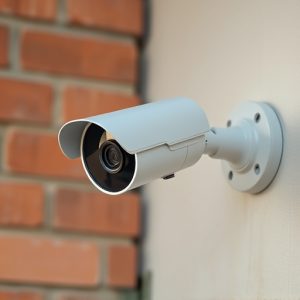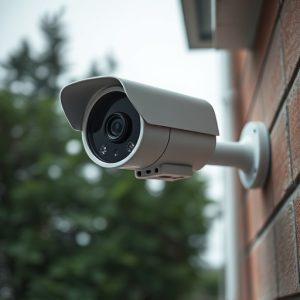Realistic Security Camera Shells: Mastering Outdoor Fake Camera Installation Height
In today's digital age, outdoor fake camera installations enhance security by leveraging realis…….
In today's digital age, outdoor fake camera installations enhance security by leveraging realistic shell designs at strategic heights (5-10 feet above ground) to deter criminals. Balancing visual realism with functionality, these "cameras," placed at or slightly above eye level, use texturing and weathering effects for an authentic look. Montaged on walls, trees, or rocks at varying heights, they create depth and credibility while providing a non-technological layer of protection.
In today’s digital era, security is paramount, yet traditional security cameras may not always deter crime. A growing trend is the use of realistic fake security camera shells as a cost-effective deterrent. This article explores the design considerations for achieving an authentic outdoor fake camera installation height, focusing on techniques to create a convincing visual illusion while maintaining both realism and functionality. Key aspects include material selection, detailed design, and strategic placement.
- Understanding the Need for Realistic Security Camera Shell Design
- Key Considerations in Outdoor Fake Camera Installation Height
- Techniques to Create a Convincing Visual Illusion
- Best Practices for Maintaining Realism and Functionality
Understanding the Need for Realistic Security Camera Shell Design
In today’s digital age, security camera systems are becoming increasingly prevalent, both in residential and commercial settings. However, simply installing cameras isn’t enough to ensure effective security; the physical appearance and placement of these devices matter just as much. This is where a realistic security camera shell design comes into play. The need for such designs extends beyond aesthetics; it’s crucial for deterring potential criminals and enhancing overall security.
Realistic camera shells, especially those designed for outdoor installations, must consider factors like the typical height of fake camera installation outdoors—a strategic placement that mimics genuine surveillance equipment. By creating replicas that look and feel authentic, these shells serve as a powerful deterrent, misleading would-be intruders into believing they’re being closely watched. This innovative approach to security adds an extra layer of protection without relying solely on technology.
Key Considerations in Outdoor Fake Camera Installation Height
When planning an outdoor fake camera installation, one of the critical considerations is the height at which the dummy camera is placed. The ideal height varies based on several factors, including the surrounding environment and the level of security desired. Typically, positioning the fake camera between 5 to 10 feet (around 1.5 to 3 meters) above ground level is recommended for maximum effectiveness. This range offers a balance between visibility and realism, making it harder for potential intruders to identify whether the camera is real or not.
At this height, the dummy camera can capture a comprehensive view of its surroundings without appearing too obvious. It provides a strategic vantage point, allowing for improved security monitoring while maintaining an aesthetic that blends seamlessly with the environment. Additionally, ensuring the camera’s visibility from different angles and distances will deter would-be thieves or vandals, making it an essential aspect of your outdoor security strategy.
Techniques to Create a Convincing Visual Illusion
To create a convincing visual illusion for an outdoor security camera shell, consider techniques that mimic reality seamlessly. One approach is to play with perspective and scale. By designing the camera housing at or slightly above eye level, it blends into the environment as if a genuine security fixture. This simple trick can fool passersby into believing they’re being watched by a real camera, enhancing the overall realism of your installation.
Additionally, incorporating subtle texturing and weathering effects can make the fake camera look aged and authentic. Think about using materials that resemble metal or plastic with a worn finish, mimicking the natural deterioration that occurs over time. Positioning the “camera” at varying heights within the landscape—on walls, trees, or even strategically placed rocks—can further enhance the illusion by introducing depth and realism to your outdoor fake camera installation height.
Best Practices for Maintaining Realism and Functionality
To achieve a realistic security camera shell design, it’s crucial to balance visual authenticity with functional considerations for outdoor fake camera installation height. Start by studying genuine camera models and their physical attributes—from casing dimensions to lens placements and mounting options. Replicating these details accurately ensures the fake camera blends seamlessly into its environment. Utilize high-quality materials that withstand outdoor conditions, such as weatherproof plastics or metal, to mimic the durability of real cameras.
When planning the outdoor fake camera installation height, consider both visibility and aesthetic harmony. Positioning the “camera” at realistic heights—whether mounted on walls, poles, or trees—enhances credibility. Avoid placing it too high or low; the typical range for security cameras is around 5 to 10 feet (1.5 to 3 meters) above ground level. This range ensures optimal field of view while maintaining a natural appearance, deterring potential intruders without appearing overly obtrusive.
In conclusion, a realistic security camera shell design is an effective deterrent for potential criminals, offering a balance between visual deception and functional surveillance. By understanding the key considerations of outdoor fake camera installation height, employing techniques to create convincing illusions, and adhering to best practices for maintaining realism and functionality, property owners can enhance their security measures while adding aesthetic value to their surroundings. This approach not only reduces crime but also contributes to safer, more secure communities.


